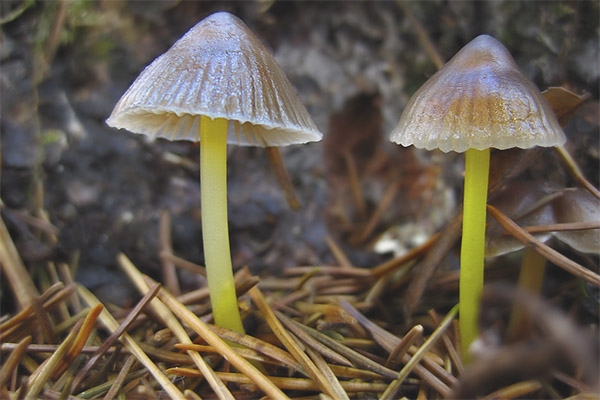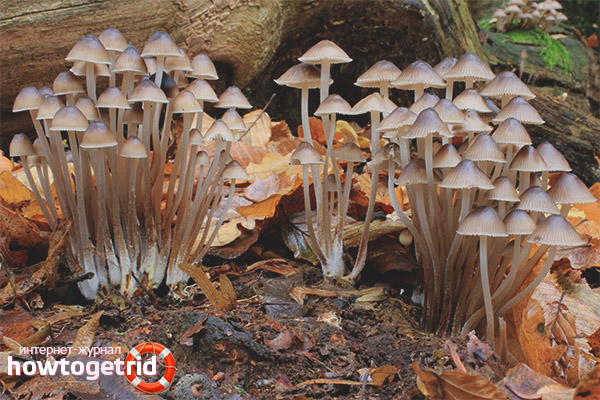The content of the article
Myzen is considered one of the varieties of hallucinogenic fungi. This fruit body can not be eaten due to its toxicity. It is important to be able to distinguish this species from oneself so as not to accidentally collect it together with edible specimens.
Mycene Varieties
If we consider these varieties on the part of the possibility or impossibility of food consumption, then it is necessary to incline to the second variant. All mycenes are not interesting from a gastronomic point of view. Some of them are poisonous, while others are classified as conditionally edible. But in practice, all fruit bodies should be avoided. Therefore, experts and incline lovers of quiet hunting prefer exclusively to edible species, but do not pay attention to hallucinogens.
But the scientific community is interested in three varieties of this family, including pink, pure, and sticky Myzen. Let us analyze their characteristics step by step.
Net
- The fruit body is unique in its kind. Distributed in various points of the globe. If you start from the opinion of mycologists, fruit bodies can be found in Africa and Greenland without any problems.
- Initially, this variety was classified as edible. However, over time, cases of poisoning began to occur more and more. Therefore, the fungus was transferred to the category of poisonous. In the composition there are psychotropic substances, which, after ingestion, cause hallucinations. In addition to the registry, “poisonous” Mycene received the second name “hallucinogenic”.
- Recognizing fruit bodies is fairly easy. The hat is bell-shaped in format, over the course of its life cycle it begins to bulge and gains volume. The diameter grows to 2-4 cm. There are notches along the edges. There is no single shade of the top, the palette is impressive. This mica can be bluish, mauve, pinkish or gray.
- Plates are not too close to each other. They are painted in mauve or coincide in shade with a hat. When the pulp goes for a break, this place is pigmented with a violet-blue tint. As for taste, they are somewhat reminiscent of radish.However, it is worth remembering the prohibition of the intake of these mushrooms in food.
- The base is thin, smoothed, in cylinder format. The inner part is empty. The foot is painted in the color of the top. Considering the fruiting season, we can say that it falls on the beginning of summer and lasts until the beginning of autumn. Mushrooms inhabit fallen leaves or conifer needles.
Sticky
- Otherwise, this species is called sticky. Initially, the tip has a bell-shaped format. But with the passage of life becomes prostrate and increases in diameter. In the middle there may be a small knoll, and near it are the stripes. Along the edges there are notches. Recognize this fruit body will be able to certain criteria.
- The tip of the width reaches 3 cm. It is smooth, glossy, has a sticky layer. In contact, glued to the skin. Hence the mushroom and got its name. The young growth is pigmented on top of brown-gray. Adult fruit bodies turn yellow with red spots. Plates are narrow, they can stick together with each other.
- The base is round, hard, high. It grows up to 6 cm. With a diameter of 3 mm.The leg is smoothed, at first it can be fluff. The color is the same as the tip or so. If you click on the base, it will get red. Under normal circumstances, it is colored yellow.
- The soft part is almost absent. It is refined and gray, it smells of rot. Growth is carried out in the coniferous strip, these fruit bodies like to eat. Develop near hemp and roots. Need a bed of needles or foliage. Find instances succeed, starting with the end of spring, ending with the beginning of autumn.
- These fruit bodies attract the attention of a person with an exquisite pinkish tinge with which the top is pigmented. In the course of the life cycle, this color becomes not so bright, it fades and soon a gray pigment is formed. Hats were originally pink, they are clearly visible against the background of the ground and foliage, so people and predators do not pass by.
- Growth is carried out exclusively in those places where there is fallen old foliage. Often, this fungus is located in the larches and coniferous strip. The basis of the fruit body is a toxic substance called muscarin.
- To use this fruit body is strictly prohibited.It will be possible to recognize it by the bright pink color of the hat in the young or gray in mature specimens. Distribution is carried out colonially or singly.
- For the development of these specimens choose the area where there is a beech or oak. The soft part is odorless, stained with white pigment. The hat is smooth, there are no bulges or incisors. The diameter of the tip never grows more than 3 cm. The edges are tucked both inwards and outwards. There may be a hill in the center.
- The plates are pigmented with pastel colors, they are large. The base is smoothed, empty, pigmented with light gray or pure white. Representatives of the genus grow in the southern region, fruiting begins in late spring and ends in the middle and end of autumn.
Virulence
- Fruit bodies concentrate poison, which, when released into the human body, affects hearing and eyesight. There are hallucinations associated with these internal organs. A person changes the perception of reality, the colors become brighter, and the sound - louder. Depending on the degree of maturity of the fantasy, variouspictures in my head.
- Sensitivity to sounds becomes strong, music is perceived differently. As part of muscarine accumulates, it is responsible for the spasms of muscle tissue of the stomach. Negative effects also affect the spleen, bladder, uterus. Pupils become small, constricted. Bile is secreted, there is a strong saliva discharge.
- When a person is poisoned by this fruit body, the state is primarily accompanied by vomiting spasms, nausea, diarrhea with pain. There may also be dizziness, agitation and hyperactivity. Then, after a period of time begins to shiver, which is accompanied by convulsive seizures and a decrease in body temperature.
First aid
- Signs of poisoning quickly make themselves known. It is necessary to carry out gastric lavage and clean the intestines. To this end, go to the hospital or implement everything on their own.
- To release the stomach, it is necessary to prepare a weakly concentrated soda or manganese solution, then drink it and, pressing on the tongue, induce vomiting.
- Next, drink sorbent (coal or polysorb). As a means to release the intestines is an enema or castor oil is drunk. Then it is important to warm the limbs and go to the hospital.
In today's article we have studied not only the description, but also other aspects, including the symptoms of poisoning and the provision of assistance, if such is required.













To send